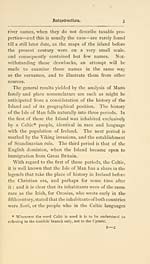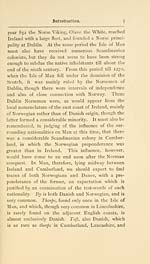Download files
Complete book:
Individual page:
Thumbnail gallery: Grid view | List view

4 aUanx Suitttant:^s antr piarc-BamcB.
would be called Ga^:/ and Gwyddyl. It is also certain
that, from the fifth to the eighth centuries, Manxmen
were mainly Christianized by Irish missionaries, as
some of these missionaries have left their names to our
ancient keeills and churches.* There are also recorded
in the same way a few names of missionaries belonging
to the Gallwegian and Columban churches, which
would tend to show a connection, though probably a
much less intimate one, with Galloway and the Western
Isles of Scotland. These Celtic influences, though
weakened by the Norse incursions and settlement, did
not entirely cease till the English connection was
finally established under the Stanleys. So firmly,
indeed, were they implanted, that as late as the end of
the eighteenth century the majorit}^ of the inhabitants
of the Isle of Man still spoke their native Celtic
tongue.
With regard to the second period, we know that
a great emigration from Scandinavia began early
in the ninth century. It took two directions, one,
mainly Danish, to the north-east of England, and the
other, mainly Norwegian, to the coasts of the Shet-
lands, Orkneys, Northern Scotland, the Western Isles,
Ireland, and the Isle of Man. The annals of Ulster
tell us that the earliest incursion of the Vikings took
place in a.d. 794, and that in 798 they burned Inis-
PATRICK, probably identical with Peel. These visitors
seem at first to have mainly used the Isle of Man as a
convenient centre for their forays upon the adjacent
coasts, and as a depot for storing their spoil till they
conveyed it home before the winter set in ; but in the
* See Chap. III.
would be called Ga^:/ and Gwyddyl. It is also certain
that, from the fifth to the eighth centuries, Manxmen
were mainly Christianized by Irish missionaries, as
some of these missionaries have left their names to our
ancient keeills and churches.* There are also recorded
in the same way a few names of missionaries belonging
to the Gallwegian and Columban churches, which
would tend to show a connection, though probably a
much less intimate one, with Galloway and the Western
Isles of Scotland. These Celtic influences, though
weakened by the Norse incursions and settlement, did
not entirely cease till the English connection was
finally established under the Stanleys. So firmly,
indeed, were they implanted, that as late as the end of
the eighteenth century the majorit}^ of the inhabitants
of the Isle of Man still spoke their native Celtic
tongue.
With regard to the second period, we know that
a great emigration from Scandinavia began early
in the ninth century. It took two directions, one,
mainly Danish, to the north-east of England, and the
other, mainly Norwegian, to the coasts of the Shet-
lands, Orkneys, Northern Scotland, the Western Isles,
Ireland, and the Isle of Man. The annals of Ulster
tell us that the earliest incursion of the Vikings took
place in a.d. 794, and that in 798 they burned Inis-
PATRICK, probably identical with Peel. These visitors
seem at first to have mainly used the Isle of Man as a
convenient centre for their forays upon the adjacent
coasts, and as a depot for storing their spoil till they
conveyed it home before the winter set in ; but in the
* See Chap. III.
Set display mode to: Large image | Transcription
Images and transcriptions on this page, including medium image downloads, may be used under the Creative Commons Attribution 4.0 International Licence unless otherwise stated. ![]()
| Early Gaelic Book Collections > Blair Collection > Surnames & place-names of the Isle of Man > (22) |
|---|
| Permanent URL | https://digital.nls.uk/82099912 |
|---|
| Description | A selection of books from a collection of more than 500 titles, mostly on religious and literary topics. Also includes some material dealing with other Celtic languages and societies. Collection created towards the end of the 19th century by Lady Evelyn Stewart Murray. |
|---|
| Description | Selected items from five 'Special and Named Printed Collections'. Includes books in Gaelic and other Celtic languages, works about the Gaels, their languages, literature, culture and history. |
|---|

